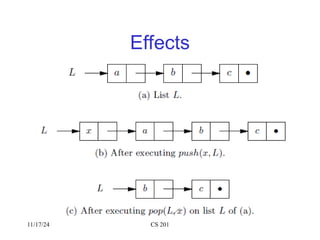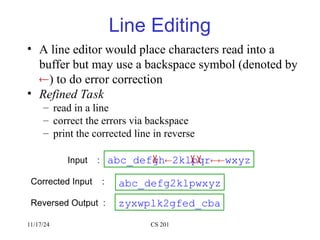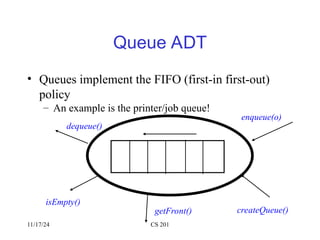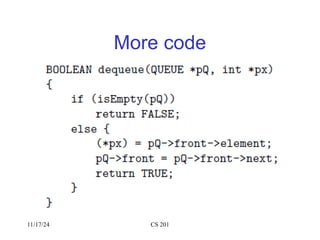cs201-list-stack-queue-linked-list (2).ppt
- 1. Data Structures and Algorithms Linked Lists, Stacks and Queues
- 2. 11/17/24 CS 201 Data Structure • A construct that can be defined within a programming language to store a collection of data – one may store some data in an array of integers, an array of objects, or an array of arrays
- 3. 11/17/24 CS 201 Abstract Data Type (ADT) • Definition: a collection of data together with a set of operations on that data – specifications indicate what ADT operations do, but not how to implement them – data structures are part of an ADT’s implementation • Programmer can use an ADT without knowing its implementation.
- 4. 11/17/24 CS 201 Typical Operations on Data • Add data to a data collection • Remove data from a data collection • Ask questions about the data in a data collection. E.g., what is the value at a particular location, and is x in the collection?
- 5. 11/17/24 CS 201 Why ADT • Hide the unnecessary details • Help manage software complexity • Easier software maintenance • Functionalities are less likely to change • Localised rather than global changes
- 7. Linked Lists
- 8. 11/17/24 CS 201 Lists • List: a finite sequence of data items a1, a2, a3, …, an • Lists are pervasive in computing – e.g. class list, list of chars, list of events • Typical operations: – Creation – Insert / remove an element – Test for emptiness – Find an item/element – Current element / next / previous – Find k-th element – Print the entire list
- 9. 11/17/24 CS 201 Array-Based List Implementation • One simple implementation is to use arrays – A sequence of n-elements • Maximum size is anticipated a priori. • Internal variables: – Maximum size maxSize (m) – Current size curSize (n) – Current index cur – Array of elements listArray n curSize a1 a2 a3 an listArray unused 0 1 2 n-1 m cur
- 10. 11/17/24 CS 201 Inserting Into an Array • While retrieval is very fast, insertion and deletion are very slow – Insert has to shift upwards to create gap a1 a2 a7 a8 a4 a5 a6 a3 Step 1 : Shift upwards 8 Size arr 8 a1 a2 a3 a7 a8 Size arr a4 a5 a6 Example : insert(2, it, arr) Step 2 : Write into gap it Step 3 : Update Size 9
- 11. 11/17/24 CS 201 Coding typedef struct { int arr[MAX]; int max; int size; } LIST void insert(int j, int it, LIST *pl) { // pre : 1<=j<=size+1 int i; for (i=pl->size; i>=j; i=i-1) // Step 1: Create gap { pl->arr[i+1]= pl->arr[i]; }; pl->arr[j]= it; // Step 2: Write to gap pl->size = pl->size + 1; // Step 3: Update size }
- 12. 11/17/24 CS 201 Deleting from an Array • Delete has to shift downwards to close gap of deleted item Step 1 : Close Gap 9 a1 a2 it a7 a8 size a5 a6 a3 a8 arr 9 a1 a2 it a7 a8 size a4 a5 a6 a3 arr Example: deleteItem(4, arr) Step 2 : Update Size 8 Not part of list
- 13. 11/17/24 CS 201 Coding void delete(int j, LIST *pl) { // pre : 1<=j<=size for (i=j+1; i<=pl->size; i=i+1) // Step1: Close gap { pl->arr[i-i]=pl->arr[i]; }; // Step 2: Update size pl->size = pl->size - 1; }
- 14. 11/17/24 CS 201 Linked List Approach • Main problem of array is the slow deletion/insertion since it has to shift items in its contiguous memory • Solution: linked list where items need not be contiguous with nodes of the form • Sequence (list) of four items < a1,a2 ,a3 ,a4 > can be represented by: item next ai a1 a2 a3 a4 head represents null
- 15. Pointer-Based Linked Lists • A node in a linked list is usually a struct struct Node { int item Node *next; }; //end struct • A node is dynamically allocated Node *p; p = malloc(sizeof(Node)); A node 11/17/24 CS 201
- 16. Pointer-Based Linked Lists • The head pointer points to the first node in a linked list • If head is NULL, the linked list is empty – head=NULL • head=malloc(sizeof(Node)) 11/17/24 CS 201
- 17. A Sample Linked List 11/17/24 CS 201
- 18. Traverse a Linked List • Reference a node member with the -> operator p->item; • A traverse operation visits each node in the linked list – A pointer variable cur keeps track of the current node for (Node *cur = head; cur != NULL; cur = cur->next) x = cur->item; 11/17/24 CS 201
- 19. Traverse a Linked List The effect of the assignment cur = cur->next 11/17/24 CS 201
- 20. Delete a Node from a Linked List • Deleting an interior/last node prev->next=cur->next; • Deleting the first node head=head->next; • Return deleted node to system cur->next = NULL; free(cur); cur=NULL; 11/17/24 CS 201
- 21. Delete a Node from a Linked List Deleting a node from a linked list Deleting the first node 11/17/24 CS 201
- 22. Insert a Node into a Linked List • To insert a node between two nodes newPtr->next = cur; prev->next = newPtr; Inserting a new node into a linked list CS 201
- 23. Insert a Node into a Linked List • To insert a node at the beginning of a linked list newPtr->next = head; head = newPtr; Inserting at the beginning of a linked list CS 201
- 24. Insert a Node into a Linked List • Inserting at the end of a linked list is not a special case if cur is NULL newPtr->next = cur; prev->next = newPtr; Inserting at the end of a linked list CS 201
- 25. Look up BOOLEAN lookup (int x, Node *L) { if (L == NULL) return FALSE else if (x == L->item) return TRUE else return lookup(x, L-next); } 11/17/24 CS 201
- 26. An ADT Interface for List • Functions – isEmpty – getLength – insert – delete – Lookup – … • Data Members – head – Size • Local variables to member functions – cur – prev 11/17/24 CS 201
- 27. 11/17/24 CS 201 Doubly Liked Lists • Frequently, we need to traverse a sequence in BOTH directions efficiently • Solution : Use doubly-linked list where each node has two pointers next forward traversal Doubly Linked List. x1 x4 x2 head x3 backward traversal prev
- 28. 11/17/24 CS 201 Circular Linked Lists • May need to cycle through a list repeatedly, e.g. round robin system for a shared resource • Solution : Have the last node point to the first node x1 x2 xn . . . Circular Linked List. head
- 29. Stacks
- 30. 11/17/24 CS 201 What is a Stack? • A stack is a list with the restriction that insertions and deletions can be performed in only one position, namely, the end of the list, called the top. • The operations: push (insert) and pop (delete) pop push(o) 6 7 2 3 Top
- 31. 11/17/24 CS 201 Stack ADT Interface • The main functions in the Stack ADT are (S is the stack) boolean isEmpty(); // return true if empty boolean isFull(S); // return true if full void push(S, item); // insert item into stack void pop(S); // remove most recent item void clear(S); // remove all items from stack Item top(S); // retrieve most recent item Item topAndPop(S); // return & remove most recent item
- 32. 11/17/24 CS 201 Sample Operation Stack S = malloc(sizeof(stack)); push(S, “a”); push(S, “b”); push(S, “c”); d=top(S); pop(S); push(S, “e”); pop(S); s a b c top e d
- 33. 11/17/24 CS 201 Implementation by Linked Lists • Can use a Linked List as implementation of stack Top of Stack = Front of Linked-List StackLL lst a1 a2 a3 a4 head LinkedListItr
- 34. 11/17/24 CS 201 Code struct Node { int element; Node * next; }; typedef struct Node * STACK;
- 35. 11/17/24 CS 201 More code
- 36. More Code 11/17/24 CS 201
- 37. 11/17/24 CS 201 Implementation by Array • use Array with a top index pointer as an implementation of stack E F 0 1 7 8 9 2 3 4 5 6 A B C D top StackAr arr A
- 39. 11/17/24 CS 201 More code
- 40. 11/17/24 CS 201 More code
- 42. 11/17/24 CS 201 Applications • Many application areas use stacks: – line editing – bracket matching – postfix calculation – function call stack
- 43. 11/17/24 CS 201 Line Editing • A line editor would place characters read into a buffer but may use a backspace symbol (denoted by ) to do error correction • Refined Task – read in a line – correct the errors via backspace – print the corrected line in reverse Input : Corrected Input : Reversed Output : abc_defgh2klpqrwxyz abc_defg2klpwxyz zyxwplk2gfed_cba
- 44. 11/17/24 CS 201 The Procedure • Initialize a new stack • For each character read: – if it is a backspace, pop out last char entered – if not a backspace, push the char into stack • To print in reverse, pop out each char for output Input : fghryz Corrected Input : Reversed Output : fyz zyf Stack f g h r y z
- 45. 11/17/24 CS 201 Bracket Matching Problem • Ensures that pairs of brackets are properly matched • An Example: {a,(b+f[4])*3,d+f[5]} • Bad Examples: (..)..) // too many closing brackets (..(..) // too many open brackets [..(..]..) // mismatched brackets
- 46. 11/17/24 CS 201 Informal Procedure Initialize the stack to empty For every char read if open bracket then push onto stack if close bracket, then return & remove most recent item from the stack if doesn’t match then flag error if non-bracket, skip the char read Example {a,(b+f[4])*3,d+f[5]} Stack { ( [ ) } ] [ ]
- 47. 11/17/24 CS 201 Postfix Calculator • Computation of arithmetic expressions can be efficiently carried out in Postfix notation with the help of a stack. Infix - arg1 op arg2 Prefix - op arg1 arg2 Postfix - arg1 arg2 op (2*3)+4 2*(3+4) 2 3 4 + * 2*3+4 infix 2 3 * 4 + postfix
- 48. 11/17/24 CS 201 Informal Procedure Initialise stack S For each item read. If it is an operand, push on the stack If it is an operator, pop arguments from stack; perform operation; push result onto the stack 2 3 4 Stack Expr 2 3 4 + * push(S, 2) push(S, 3) push(S, 4) arg2=topAndPop(S) arg1=topAndPop(S) push(S, arg1+arg2) arg2=topAndPop(S) arg1=topAndPop(S) push(S, arg1*arg2) 3+4=7 2*7=14
- 49. 11/17/24 CS 201 Summary • The ADT stack operations have a last- in, first-out (LIFO) behavior • Stack has many applications – algorithms that operate on algebraic expressions – a strong relationship between recursion and stacks exists • Stack can be implemented using arrays or linked lists
- 50. Queues
- 51. 11/17/24 CS 201 What is a Queue? • Like stacks, queues are lists. With a queue, however, insertion is done at one end whereas deletion is done at the other end. • Queues implement the FIFO (first-in first-out) policy. E.g., a printer/job queue! • Two basic operations of queues: – dequeue: remove an item/element from front – enqueue: add an item/element at the back dequeue enqueue
- 52. 11/17/24 CS 201 Queue ADT • Queues implement the FIFO (first-in first-out) policy – An example is the printer/job queue! enqueue(o) dequeue() isEmpty() getFront() createQueue()
- 53. 11/17/24 CS 201 Sample Operation Queue *Q; enqueue(Q, “a”); enqueue(Q, “b”); enqueue(Q, “c”); d=getFront(Q); dequeue(Q); enqueue(Q, “e”); dequeue(Q); q front back a b c e d
- 54. 11/17/24 CS 201 Queue ADT interface • The main functions in the Queue ADT are (Q is the queue) void enqueue(o, Q) // insert o to back of Q void dequeue(Q); // remove oldest item Item getFront(Q); // retrieve oldest item boolean isEmpty(Q); // checks if Q is empty boolean isFull(Q); // checks if Q is full void clear(Q); // make Q empty }
- 55. 11/17/24 CS 201 Implementation of Queue (Linked List) • Can use LinkedListItr as underlying implementation of Queues a1 a2 a3 a4 head tail Queue lst LinkedList addTail
- 56. 11/17/24 CS 201 Code struct Node { int element; Node * next; }; struct QUEUE { Node * front; Node * rear; };
- 57. 11/17/24 CS 201 More code
- 58. More code 11/17/24 CS 201 CELL is a list node
- 59. 11/17/24 CS 201 Implementation of Queue (Array) • use Array with front and back pointers as implementation of queue Queue arr 0 1 7 8 9 2 3 4 5 6 A B C D E F G front back
- 60. 11/17/24 CS 201 Circular Array • To implement queue, it is best to view arrays as circular structure 0 1 7 8 9 2 3 4 5 6 A B C D E F G front back front back A B C D E F G 0 1 7 8 9 2 3 4 5 6 Circular view of arrays.
- 61. 11/17/24 CS 201 How to Advance • Both front & back pointers should make advancement until they reach end of the array. Then, they should re-point to beginning of the array front = adv(front); back = adv(back); int adv(int p) { return ((p+1) % maxsize); } Alternatively, use modular arithmetic: mod operator int adv(int p) { int r = p+1; if (r<maxsize) return r; else return 0; } upper bound of the array
- 62. 11/17/24 CS 201 Sample Queue *Q; enqueue(Q, “a”); enqueue(Q, “b”); enqueue(Q, “c”); dequeue(Q); dequeue(Q); enqueue(Q, “d”); enqueue(Q, “e”); dequeue(Q); a Q F=front B=back F B b c d F B B B F F B B e
- 63. 11/17/24 CS 201 Checking for Full/Empty State What does (F==B) denote? F B Queue Empty State c d e B F f Queue Full State size 0 size 4 c d e B F Alternative - Leave a Deliberate Gap! No need for size field. Full Case : (adv(B)==F)
- 64. 11/17/24 CS 201 Summary • The definition of the queue operations gives the ADT queue first-in, first-out (FIFO) behavior • The queue can be implemented by linked lists or by arrays • There are many applications – Printer queues, – Telecommunication queues, – Simulations, – Etc.










![11/17/24 CS 201
Coding
typedef struct {
int arr[MAX];
int max;
int size;
} LIST
void insert(int j, int it, LIST *pl)
{ // pre : 1<=j<=size+1
int i;
for (i=pl->size; i>=j; i=i-1)
// Step 1: Create gap
{ pl->arr[i+1]= pl->arr[i]; };
pl->arr[j]= it; // Step 2: Write to gap
pl->size = pl->size + 1; // Step 3: Update size
}](https://image.slidesharecdn.com/cs201-list-stack-queue2-241117102838-d6674f1f/85/cs201-list-stack-queue-linked-list-2-ppt-11-320.jpg)

![11/17/24 CS 201
Coding
void delete(int j, LIST *pl)
{ // pre :
1<=j<=size
for (i=j+1; i<=pl->size; i=i+1)
// Step1: Close
gap
{ pl->arr[i-i]=pl->arr[i]; };
// Step 2: Update
size
pl->size = pl->size - 1;
}](https://image.slidesharecdn.com/cs201-list-stack-queue2-241117102838-d6674f1f/85/cs201-list-stack-queue-linked-list-2-ppt-13-320.jpg)































![11/17/24 CS 201
Bracket Matching Problem
• Ensures that pairs of brackets are properly matched
• An Example: {a,(b+f[4])*3,d+f[5]}
• Bad Examples:
(..)..) // too many closing brackets
(..(..) // too many open brackets
[..(..]..) // mismatched brackets](https://image.slidesharecdn.com/cs201-list-stack-queue2-241117102838-d6674f1f/85/cs201-list-stack-queue-linked-list-2-ppt-45-320.jpg)
![11/17/24 CS 201
Informal Procedure
Initialize the stack to empty
For every char read
if open bracket then push onto stack
if close bracket, then
return & remove most recent item
from the stack
if doesn’t match then flag error
if non-bracket, skip the char read
Example
{a,(b+f[4])*3,d+f[5]}
Stack
{
(
[
)
}
]
[ ]](https://image.slidesharecdn.com/cs201-list-stack-queue2-241117102838-d6674f1f/85/cs201-list-stack-queue-linked-list-2-ppt-46-320.jpg)

















